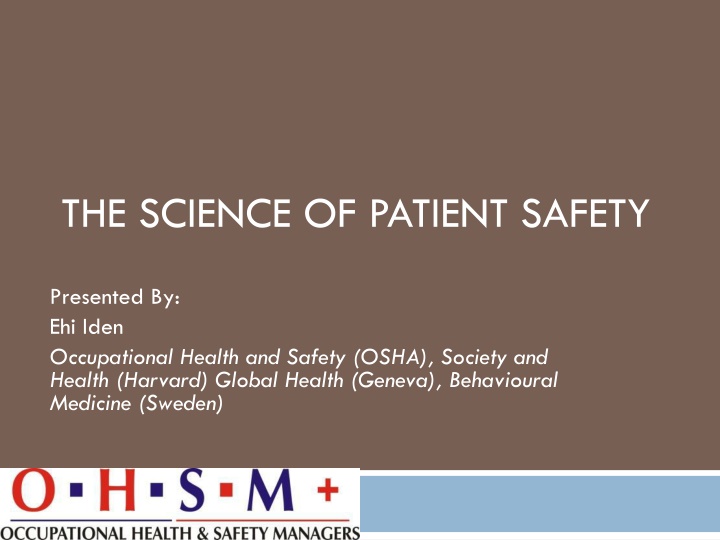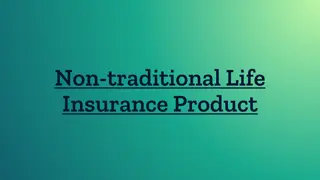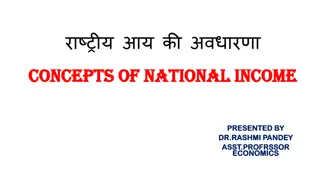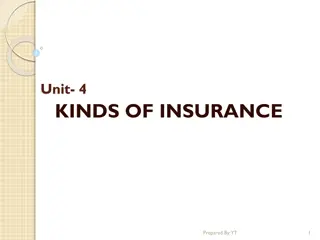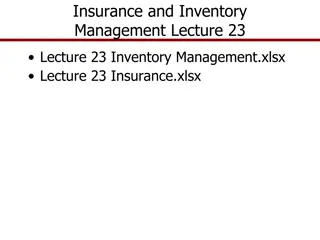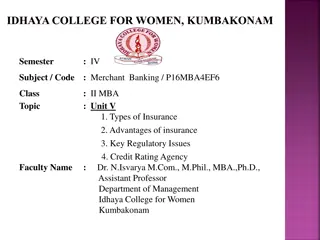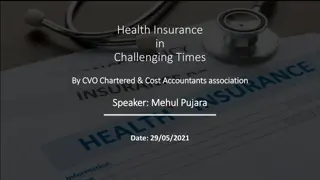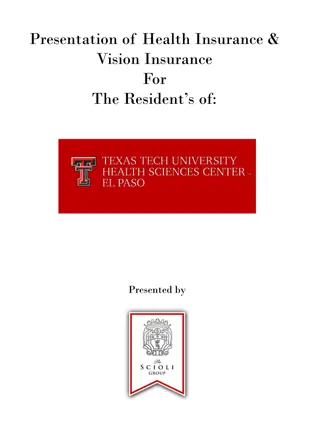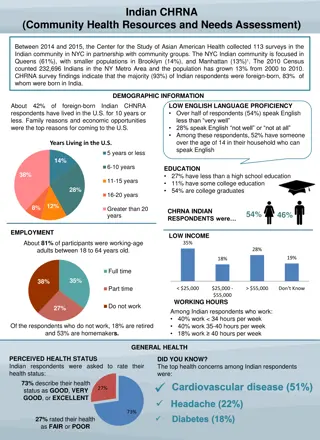Innovation in Health Insurance Product Offerings in the Indian Market
This content discusses innovation in health insurance product offerings in India, highlighting the current scenario of healthcare, challenges faced by the industry, and perspectives from insurers and policyholders. It also explores the evolution of health insurance sales and technology adoption over the years, emphasizing the need for standardization and addressing the funding dynamics of healthcare in India.
Download Presentation

Please find below an Image/Link to download the presentation.
The content on the website is provided AS IS for your information and personal use only. It may not be sold, licensed, or shared on other websites without obtaining consent from the author.If you encounter any issues during the download, it is possible that the publisher has removed the file from their server.
You are allowed to download the files provided on this website for personal or commercial use, subject to the condition that they are used lawfully. All files are the property of their respective owners.
The content on the website is provided AS IS for your information and personal use only. It may not be sold, licensed, or shared on other websites without obtaining consent from the author.
E N D
Presentation Transcript
THE SCIENCE OF PATIENT SAFETY Presented By: Ehi Iden Occupational Health and Safety (OSHA), Society and Health (Harvard) Global Health (Geneva), Behavioural Medicine (Sweden)
The concept of patient safety What exactly is patient safety? The World Health Organisation (WHO) defines patient safety as the prevention of errors and adverse effects to patients associated with health care. Patient safety is a new healthcare discipline that emphasizes the reporting, analysis, and prevention of medical error that often leads to adverse healthcare events. Wikipedia
The WHO Patient Safety Program Patient safety program was set up as a special program following World Health Association (WHA) resolution 55.8 to: Coordinate, disseminate, accelerate improvements in patient safety worldwide It was launched in 2004 with the hope of putting patient safety on the world s agenda Clean care is safer care and Safe surgery saves lives early messages
Rationale for Patient Safety Institute of Medicine publication reveals in the U.S healthcare system the following: 7% of patients suffer a medical error Every patient admitted to an ICU suffers an adverse event 44,000 98,000 deaths per year can be attributed to medical error This has a 50 billion USD as total cost Similar results exist also in UK and Australia This has been argued as underestimated. A strong contributor is the under reporting or also a recognition that an event of safety concern has occurred
Why do these errors happen? We must recognise that everyone is fallible We must design systems that arrest the mistakes before they get to the patients We must recognise that every system is perfectly designed to achieve the results it gets, properly designed systems can offer safer choices
Without leadership commitment, patient safety is only a dream Institutional and cultural factors are the strongest drivers of patient safety in healthcare No system survives outside governing policies Standards are created out of policies Responsibility naturally comes to play where a standard is in existence This brings about system s accountability We must be trained to work as a team Be mindful that when you are changing things as system improvements, you might also be introducing new risks We must understand that every improvement requires change and every change is definitely not an improvement
4 key points to driving patient safety You clearly define goals and measures from the board to the bedside (everyone focusing on zero infection or errors) Create a supporting infrastructure (core group to support the work) Engage frontline connections and create culture for peer learning report accountability structure Transparently results and create
Leadership witnessing of mistakes Do not only report on what we are doing right, we should also report what we are doing wrong The need to take responsibility of the kind of care given in our institution is crucial We must create a culture where people must believe it is safe to report (I will be protected) It is not about the reports, it is what we do with the reports
Building safety into the system Focus is on patient centred care (comprises of the principal patients and their family members) We must be trained to work as a team We must also be mindful that when we are changing or improving our systems, we might also be introducing new sets of risks Every improvement requires change and every change is definitely not an improvement
Patient Centred Care (PCC) The caregiver-patient relationship has often times been characterised as silencing the voice of the patients It is now widely agreed that putting patients at the centre of healthcare,by trying to provide a consistent, informative and respectful service to patients, will improve both outcomes and patient satisfaction. When patients are not at the centre of healthcare, when institutional procedures and targets eclipse local concerns, then patient neglect is possible. There have been recommendations that the health service puts patient experience at the heart of what it does, and especially, that the voice of patients be heard loud and clear within the health services
PCC: Healthcare through the patients eyes Multiple dimensions to PCC Respecting patients needs, values & preferences Focus on the who person Offering emotional support and alleviating physical discomfort Communicating adequately, sharing information and providing education Strengthening patient-provider relationship by including family and friend
What does it take to meet a patients need Jonathan s story In the United States, patients pain had become a very significant part of healthcare delivery Pain assessment has not been classified as the sixth vital sign Failure to address patients needs can influence the patients ability to participate in hospitalization Care-traumatised patients do not end up with good treatment outcomes Patients are termed vulnerable in the hospital, it is important to provide them with both physical and emotional support their care delivery during
Pre to- Post hospitalization Prepare patients well enough for hospitalization Manage all patients needs, identified ownership of case Engage them in the management of their care Speak daily with them, discuss their care plan and goal for the day Take into account patients value and preference in the treatment plan Provide adequate information even at discharge to help patient recover well They need to be educated on the health conditions they were treated for and let them know what to watch out for
Engaging patients relatives in direct care These are very integral components of our overall care cycle but mostly ignored and forgotten Treatment or interventions are termed successful if there are no hospital returns (re-admission) on same case Studies have shown that treatment outcomes are most times better when patients relatives are engaged We partner with family members to enact care and connect better with sick relatives
Reasons why we must listen to patients Patients spend more time in health care services than any regulator or quality controllers Patients can recognize problems such as service delays, poor hygiene and poor conduct Patients are particularly good at identifying soft problems, such as attitudes, communication and 'caring neglect that are difficult to capture with institutional monitoring One important way in which patients can be put at the centre of healthcare is for health services to be more open about patient complaints
The Stafford Hospital Scandal The Stafford Hospital scandal concerns poor care and high mortality rates amongst patients at the Stafford Hospital, Stafford, England, in the late 2000s. A full scale investigation was carried out between March and October 2008. Report released in March 2009, the commission's report severely criticised the Foundation Trust's management and detailed the appalling conditions and inadequacies at the hospital. Many press reports suggested that because of the substandard care between 400 and 1,200 more patients died between 2005 and 2008 than would be expected for the type of hospital.
The Winterbourne View hospital Abuse The Winterbourne View hospital abuse occurred at Winterbourne View, a private hospital in England. Local social services and the English national regulator (Care Quality Commission) had received various warnings but the mistreatment continued. One senior nurse reported his concerns to the management at Winterbourne View and to CQC, but his complaint was not taken up. The undercover footage showed staff repeatedly assaulting and harshly restraining patients under chairs. Staff gave patients cold punishment showers, left one outside in near zero temperature, and poured mouthwash into another's eyes. They pulled patients' hair and forced medication into patients' mouths. Victims were shown screaming and shaking, and one patient was seen trying to jump out of a second floor window to escape the torment, and was then mocked by staff members. One patient was repeatedly poked in the eyes.
Principles of safe design Standardization Eliminate steps (the ATM philosophy) Create check lists (the pharmacy example) Create a clear communication protocol Learn when things go wrong. What happened? Why? What to do to reduce the risk, review of controls etc. Training and education Effective supervision Create mutual support No blame game
Basic components in process of communication Ensure the message sent by provider A is same as received and understood by provider B This might be through phone call in healthcare or other acceptable communication medium Coding and decoding a message may happen through out the course of the day Trust nothing to assumption, someone might just be paying for that
Team work tools Conduct staff safety assessment Daily goals: This is examined to be sure we are all in tune of expectations for the day AM briefing otherwise known as morning hurdle (this brings all team members together to confirm what the plan of care is) Shadowing: This is done to know how other team members are carrying out care, a nurse following a Doctor or vice versa Barrier identification and mitigation Learning from defect. If only we reviewed what we have done wrong
The system: The issue Patient safety is systems driven When things go wrong, system takes the blame To improve performance, we need a deliberate system s review and change Start with a pilot case. Pick up one process that can be improved upon Adopt the CUSP concept (Comprehensive Unit-based Safety Program). A Unit s intervention to learn from mistakes and improve safety culture
You are not alone Studies have shown that, 200 300 patients die in U.S hospitals annually from preventable harm In healthcare your personal effort does not change everything, TEAM WORK is a better game Do not play a man down When you feel something, say something
Safety culture A safety culture is characterised by a collective mindfulness that can be achieved only when there is mutual respect among team members and an absence of fear and intimidation. The key components include: Collective Mindfulness: We are aware things can go wrong, we are fallible, errors could happen and we are mindful of all that and ready to tackle it without regard to rank or status. Accountability: Accepting responsibility for making a patient safer. Report errors, near misses or any safety concern. Empowerment and engagement: Makes employees feel safe to voice out their concern about safety issues, and makes them take charge of the safety of not just their patients but colleagues alike. I. II. III.
Creating a culture of safety Patients management in our past culture We focused on blaming and punishing the individual providers rather than taking system s responsibility There was little or no emphasis on how we can learn from our errors, no transparency and we could not own up to what happened. We ended up creating a punitive work environment that shut everyone up suffer today because of the error
When blame game hurts the system Blame game limits learning from errors because the incident was never discussed It increases likelihood that the error will reoccur. This is because other colleagues were not able to benefit or learn from the problem we have had It may drive away self-reporting of adverse events It could creates vicious cycle that decreases learning The more we blame, the more providers stop talking The quieter providers are, the less we learn The less we learn, the less we improve The less we improve, the more at risk patients are
Outcome 50 years old nurse with 25 years at Seattle Children s hospital Mistakenly dispensed 1.4 grams of calcium chloride instead of the correct dose of 140 milligram for an 8 months old child in Sept 14 2009. She reported the case and owned up to be responsible After the infant s death, Kim was placed on administrative leave and soon dismissed in weeks following Her license withdrawn, she cried for 2 weeks not because of her license but that she killed a child Kim Hiatt eventually committed suicide on April 3, 2010 Hiatt s dismissal and her death raise larger questions about the impact of errors on providers, the so-called second victims of medical mistakes. That s a phrase coined a decade ago by Dr. Albert Wu, a professor of health policy and management at the Johns Hopkins Bloomberg School of Public Health
Some quotes out of this I messed up, Kim wrote. I ve been giving CaCI [calcium chloride] for years. I was talking to someone while drawing it up. Miscalculated in my head the correct mls according to the mg/ml. First med error in 25 yrs. of working here. After the incident, Hiatt "was a wreck, recalled Julie Stenger, 39, of Seattle, a critical care nurse who worked with Hiatt at the hospital. No one needed to punish Kim. She was doing a good job of that herself. When she lost this job, it wasn t just the job she lost, it was her future. Kim s mum She was in such anguish, Crum says. She ran out of coping skills. Punitive actions are actually counterproductive. Everything in the literature points to that not being the right step to take, Watkins said. Nurses in that unit or hospital will not report things. There s this heightened awareness: It could be me. I thought it was sending the exact wrong message: If you make a mistake, you better keep your mouth shut about it. Kim s colleague
The complexity in healthcare. Healthcare is a complex system that has many interacting parts. complexity comes chances of defects Increased with an increased Because of this complexity in healthcare, it is difficult to say this is the particular part where the issues are coming from. This is the most potent reason why it is better to consider the system as a whole and not in parts.
Some components of healthcare systems The Healthcare system is characterised with interrelated and interdependent complex components. These include: Technology and tools Organisation Environment Task Persons These components interact to impact on: a. Patients outcome b. Individual and organisational outcome
Communication in healthcare This is the frontline safety net for everyone in the healthcare sector irrespective of rank Most times effective communication is challenged in hospital and resulting to adverse effects We have barriers as: Intrapersonal barriers to communication Interpersonal barriers to communication I. II. III. Organisational barriers to communication
Structured communication strategies Assertive style: Get providers attention, use names, you must be clear, concise and timely. Present a problem in non intimidating and non disrespectful manner. SBAR style (Situation, Background, Recommendation). Check the SBAR example below. Assessment and RN identifies patient and purpose of call S: RN informs a Doctor of the deteriorating condition B: RN gives background of the patient A: RN gives change in patient s assessment R: RN recommends what he/she thinks needs to be done
.communication The CUS technique: C: I am Concerned U: I am Uncomfortable S: I do not think the current situation is Safe CUS is a signal phrase, it is brief. It is used to get someone s immediate attention and only when appropriate. I. II. III. The two Challenge Rule: (you need courage to use this) If you believe the patient safety is being compromised You have been assertive in communication and You have failed to get the providers attention Let the provider know, you are going up the chain of command to resolve concern
communication When a provider is challenged by another team member on a course of action of a patient, the provider s responsibility is to: Listen Acknowledge the expressed concern Maintain respectful communication pattern IV. Provide a rationale for a no-action I. II. III. Remember, communication is the human connection to personal and career success
Mutual Support Mutual support is the essence of team work, It simply means backing up your fellow team member. It protects team members from overload situations that may reduce effectiveness and increase the risk to error We do not necessarily have to wait till we are asked or invited, we use our discretion to identify overload as a safety concern
When is Mutual Support Needed Anytime a unit falls into work overload mode This can be evident when: There are unexpected events on a unit New patients being simultaneously admitted in the unit There is a mismatch between providers skills and patients care need There are abrupt changes in patients status I. II. III. IV.
Disruptive behaviour in healthcare Disruptive behaviour is a personal conduct whether verbal or physical, that negatively affects or that potentially may affect patients care and /or interferes with ones ability to work with other members of the healthcare team. Disruptive behaviour is any behaviour that undermines the culture of safety Joint commission 2008 It is a complex presentation that causes patient harm You have the following: Bad actors: People involved in disruptive behaviour Enablers: Their silence most times means approval of DB Collaborators: They preserve culture that allows the behaviour Bystanders: The ones who fail to respond to behaviours e.g. the CEOs, CFO, COO, CMO. They watch people display disruptive behaviour and fail to respond I. II. III. IV.
In closing Part 2 Learning from defects (LFD) Disclosing adverse effects Available disclosure policies Translating Evidence Into Practice (TRIP) model Metaphors to leading change Business case for safety in healthcare The need for improvement in science
